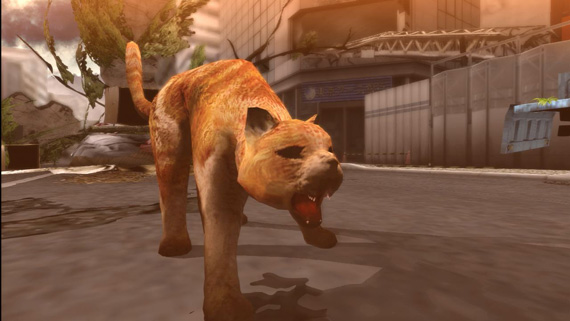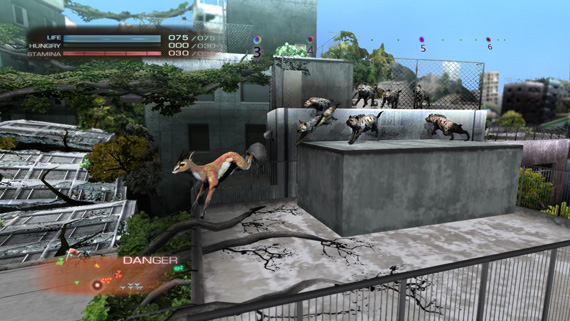
A fresh litter of calico kittens play atop the deserted shops of Shibuya, soon abandoning the safety to follow the lead of their most curious sibling into the rainy streets below. The pack quickly tests their claws and teeth against the helpless chickens and pigs that scatter in panic at the sudden emergence of the newly born predators.
Though the kittens will quickly grow larger from the feast, the never-ending red pangs of hunger and scarcity of prey will drive the pack from the shops of their youth toward the broken streets of Shibuya Station. The young cats push forward while claiming the stray rabbits and chicks seeking shelter in the patches of forest slowly reclaiming the land through cracking cement and decaying automobiles.
Marking their territory along the way, the cats could easily choose to settle into their nest atop the train tracks and relinquish the fight for survival to a new generation. But youthful exuberance and curiosity causes them to follow their pack leader further in the search for new prey and territory to conquer. And as the swarm reaches Dogenzaka, the prey becomes dangerously scarce, changing the balance of this struggle as they encounter a cougar seeking to feed the same need.
Despite their numbers, several of the cats immediately fall to the wild swipes of this predator. Though two escape down a narrow alley, the beat of hunger pounds in rhythm with falling health to see them surrender to the scavengers overhead as they lay down in the street and lose their bid for rule over the Tokyo Jungle.

With the Mayan Apocalypse encouraging us all to exchange gifts early this year, it seems appropriate to give a nod to Sony Japan’s own take on the inevitable future of the planet. While lacking the pedigree required for game of the year, and even the game’s publisher seeming hesitant about the odds of the game finding an audience in North America prior to release and critical love, the digital release of Tokyo Jungle remains one of my favorite titles in this year of gaming 2012.
In many ways, purposeful or not, Tokyo Jungle is a love-letter to the strange and random experiments that littered the PlayStation 2 section of retail shelves. A game where your mate can give you fleas and dog eats dog while wearing silly sunglasses and jackets.
But the quirks that lend enduring charm fail to blanket the salvage operation here – Tokyo Jungle is an obtuse release that comes across entirely ass-backwards, sporting a monetary agenda for flaunting DLC animals that is cause enough to roll up a newspaper and smack Sony on the snout.
Aside from the initial tutorial that teaches players the basics of hunting, hiding, and breeding to ensure the survival of their chosen species, the game’s story mode remains locked at the outset.
The strange twist here requires players to earn their points and scars in the game’s survival mode, which could have functioned as an arcade release. While working to encounter and unlock additional species of animals, players will also discover documents and slowly unlock additional chapters of the story mode, thereby left to flip between the two modes to fulfill any lingering interest in learning about the fate of humanity that has left the city streets to become a jungle.
And yet, forcing players through endless rounds of survival mode exposes us all to the core interest, the random chance and varying conditions that make every fight for dominance in this Tokyo Jungle familiar but slightly different.
It certainly helps that, as jagged as the design can be at times, it stretches but never breaks. Though sometimes killing a prey on top of a building will find you eating it suspiciously over the edge of said building, the simplicity of the controls for attack and defense and the repetitive need to feed encourages players to stay mobile – creating a rhythm that offers easy access and strangely hypnotic cause for revisits. There’s simply less time to gloss over those rougher edges when rabbits scurry and demand your attention, because if you stop to think about anything too long, the game is already lost.
And the bizarre design that requires one to stop and check the map more often than seems reasonable still manages to provide a remarkably interesting landscape connecting all the suburbs of this jungle via narrow passageways through the collapsing infrastructure that serves as a decaying marker for the human race.

In the streets of Shibuya, a young deer extends its long legs to race first steps across the pavement, feeding on the plants between flags it must mark to assert dominance over the area to gain any chance of passing on its growing skills to a new generation.
Other herbivores sleep peacefully beside patches of grass and small trees extending the reach of the forest into areas once forbidden by some near forgotten species. Days seem like seconds as the deer reaches two years before learning half of the area it hopes to discover a mate within.
And then, just as it nears the final marker that will allow it to gain dominance over the sleepy street, two hungry dogs lay waiting for foolish prey. The deer scrambles and kicks at the predators, managing to strike one only to find the other lunge forward and sink its teeth in for the kill, ending the deer’s short-lived bid to survive in the Tokyo Jungle.

While survival mode lends a certain Grand Theft Auto flavor, with players given free range to hunt other animals and mark the territory that will attract a mate, the continual challenges offered lend purpose over the need to feed a hunger that consistently threatens to bring each session to a premature end.
These challenges mirror that basic need, tasking players to reach a certain area and consume or kill prey by certain means before reaching a set age – and it’s certainly worth noting that time flies in the Tokyo Jungle, where a life can begin and end in a matter of minutes, but also accomplish a great deal in an equally short amount of time.
Surviving and chaining these bursts of play with each successive generation of a species is continually challenged by the need to mark new territories, where the potential absence of prey and the presence of more powerful predators is the constant fear. While one generation may find the streets overrun with prey to feed stability, offspring of the next generation will likely find it necessary to run through empty streets hoping to find any sign of life to stave off the constant beating of the hunger gauge.
What makes this endlessly fascinating is that there’s no way to know if the next corner will reveal an easy meal of napping prey, or lead players smack into the hungry jaws of a lion and her cubs.

At seventeen years old, the beagle’s once sharp skills begin to fade as the thrill of the hunt ages along with the teeth and claws that enable the dance of nature that his guided him to this point. Though the opportunity for still more successful hunts remain, the old hound marks the territory surrounding the Shibuya Woods and settles with his mate into a gathering of hay atop the side of a collapsed building.
As a puppy, the beagle traveled here from the Shibuya Shop District, growing throughout the journey while taking down the first of many rabbits that would stave off the consistent hunger threatening every beast fighting to survive in this new jungle. But the fight for dominance over the elevated safety of the rotting infrastructure of the woods wasn’t easy, his only sibling dying as the two fought packs of retrievers running wild over the crumbling rooftops and broken stairwells.
Settling into the safety of his nest to produce the fourth generation of his line, the beagle can’t foresee that his puppies will have far less success in the fight for survival, despite inheriting some of the skills honed during his time here. He’ll never know that the rising plume of toxins will drive his descendants Eastward, or that the scarce supply of prey will cause them to desperately push too far into the lion’s den that once served as a train yard for a forgotten species. There’s no way for the beagle to know that random chance and circumstance will mean that he is the last in his line to rule over territory with his mate by his side.
There’s only the fleeting awareness that at a particular moment in time, his quest for survival saw him gain a tiny square of land where he could feel the hard fought and short-lived comfort that comes with becoming a King in the Tokyo Jungle.
This read was awesome. You rock. It makes me want to play this game. Sounds kind of like a Roguelike, one of my favorite type of games. Almost wish this was PSP Vita cross-play compatible as that would make playing it far easier for me these days.
Comment by Ujn Hunter — December 12, 2012 @ 2:14 pm
Thanks Tim. I think Sony kinda wishes it was too haha :)
Comment by Jamie Love — December 12, 2012 @ 2:49 pm
I’ve tested out the newly released patch that includes “Remote Play” but it’s not very good. It’s like watching a low quality Youtube video on your PSP Vita. The game would have to be totally remade for the handheld to be enjoyable. I’ll stick to playing on my PS3 from now on.
Comment by Ujn Hunter — January 3, 2013 @ 11:44 am
Appreciate the update, I meant to check it out this week but still haven’t taken the time to see how it plays. Still bonkers they didn’t have crossplay in mind from the start.
Comment by Jamie Love — January 5, 2013 @ 7:17 pm
This game is so peculiar. Very strange to get to grips with at first, and as I realised I hadn’t been saving, my death the last time I played it felt particularly brutal and game ending as I threw away progress. There are times where I feel that surviving is totally impossible with tigers to the left of you, lions on the right but if nothing else it’s certainly an experience unlike anything else. Great review, makes me want to go back and give it another go to try and earn myself a better species than the alley cat I’m currently playing as.
Comment by Stuart Price — December 12, 2012 @ 5:26 pm